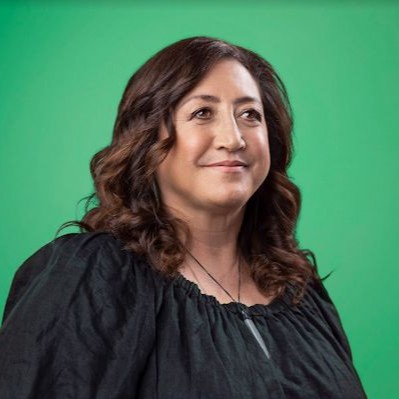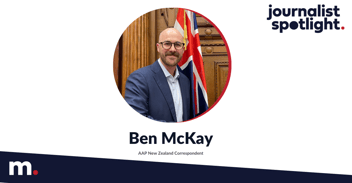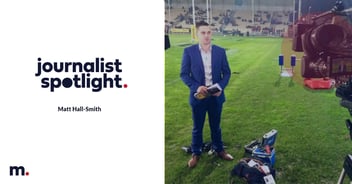Journalist Spotlight | Interview with Carmen Parahi, Pou Tiaki Matua Executive at Aotearoa New Zealand’s, Stuff
Carmen Parahi is forging a path as the Pou Tiaki Matua Executive at Aotearoa New Zealand’s, Stuff, reconciling with her Māori ancestors and helping others to do the same. 
What does a normal day look like for you?
For me, a normal day looks like getting my children out of the house in time for school and then getting myself to work. Then starting the day with our daily meeting in the Auckland office about what's happening in editorial or commercial, and other parts of the business. We discuss stories of the day, and we also learn the kupu Māori of the day, which is the Māori word of the day.
Māori language or te reo Māori is a big component of the work we do at Stuff, we're helping the people at Stuff learn to be comfortable and confident with pronouncing te reo Māori words, using te reo Māori and normalising te reo Māori.
Our digital mastheads, which we launched this year, have bilingual titles, and I love it because it shows a modern New Zealand. So it shows that we are normalising te reo Māori and the use of te reo Māori.
On the Stuff website you’ll see that we have a little phrase, “Kia Ora, Aotearoa!” which is “Hello, New Zealand!”. We started that 3 years ago, and you wouldn’t believe the outcry we experienced. We had official complaints against us that went to the media council. Later that year, the Media Council and the Broadcasting Standards Authority ruled that media companies in New Zealand can use te reo Māori as they see fit. That was a milestone because it showed that we were growing up as a country, and understanding that te reo Māori is a language for all people that are in Aotearoa New Zealand.
I am also the Pou Tiaki Matua at Stuff. Our pou tiaki is our anti-discrimination, fair representation strategy which we started 3 years ago. My role as the Pou Tiaki Matua is to hold the company accountable to our company charter and helping our audience see what we mean by pou tiaki. So pou tiaki, includes a whole lot of actions that includes showcasing pou tiaki stories and the pou tiaki section on Stuff.
Pou tiaki is the Māori word for guard post. Pou tiaki guards and helps us to guard against discrimination in our own behaviours and actions, but also guard against discrimination in Aotearoa New Zealand. At Stuff, we recognise and understand what discrimination looks like in a media organisation or industry.
We created pou tiaki because as news tends to do, it can be very negative, and often when we talked about Māori, it was only when the headlines were negative. So it is understanding that we have to provide all sorts of coverage of Māori, and my role is to uphold pou tiaki.
Do you have specific tools that you implement for different mediums of media? Do you think there are different challenges between digital, television, and radio?
Because we are a multimedia company, so, papers, print, digital, audio and visual, we have to provide pou tiaki support across all of those channels, and it's not that we provide different focus on each of the different mediums, everyone has to be their own pou tiaki.
So it’s helping everyone understand that the western news media has European traditions, so we have normalised European culture and practises in all that we do. New Zealand and Australia were created through colonisation, and the media is a colonial system, and that colonial system has Euro-centric mono-cultural traditions. So what it means is that we often do news through that European lens. What it means is that anyone outside that European lens, is excluded, or expected to just receive, and be represented in, the news. So pou tiaki is trying to help us use multiple lenses.
It’s not so much that we treat the mediums differently, there are so many underrepresented communities in the media, all outside the euro-centric lens. We have to remind ourselves to think on behalf of all of those people as well. That's what we’re trying to teach our staff to do, and then represent that in our different mediums.
What do you think media outlets can do better to improve indigenous representation? Is it to have more indigenous reporters reporting, or do you think it's important to have all-indigenous platforms? Is there any advice you could give to the media in general?
Oh I could give advice all-day long. Indigenous voices and stories need to come from multiple sources. There is no one answer, and no one representation for all. So you need culturally safe spaces for indigenous people to be in. If your space is not culturally safe for them why would they be there? A culturally safe space is a place where people are educated and understand, and are respectful of culture. They allow indigenous people to tell indigenous stories their way, not the way of the organisation, which are two different ways.
So that is creating opportunities and roles within an organisation that are held by indigenous people. We also need media training institutions to be culturally safe spaces for indigenous people. So that they can feel safe in journalism, and they can feel safe to know that whatever lens they bring, it is going to be appreciated.
What does an informed audience look like to you? Are there particular sorts of media and voices that an audience should seek?
You would find good journalists that you can trust with the news that you are delivering, media organisations that are aware of their discrimination and have done work to understand and stop their discriminatory practices.
The beauty of having a place like Māori Television, Pou Taiki Māori, or Iwi Radio, our tribal radio stations, is that they are Māori, so their lenses are always going to be Māori. If you’re Māori you would know that you can trust those sources from a cultural perspective. For non-indigenous media, you need to understand what the company stands for and if there is anything they've done in the past or currently that tells you that they’re on a pathway to better represent indigenous people, or underrepresented communities. You would know that because of the types of stories they publish and how much language is seen or heard.
What people have to understand about the news and the media, is that they are snapshots. You’ll never get fully informed by one news article. You will be informed if you follow an issue over a period of time. Obviously if you want to be informed about indigenous issues you go to indigenous media. If you know your history, you can understand the results of that history because they are in front of you today.
Something wonderful that Stuff supported was getting Māori and New Zealand history taught in schools, which is compulsory now. It started this year, and it means that schools have to engage with local Māori, it’s amazing because those generations will be miles ahead of anybody else.
Finally, do you have a favourite moment from your career so far?
Oh yes I’ve got heaps. It’s a hard one because I’d hate to say that I’m old, but I may be. It could be taking my daughter to work when she was only 3 months old in the early 2000’s. I was having to breastfeed her in the newsroom while trying to write news stories, that’s a fond memory.
One of my memories that I love, where we were able to make a positive impact, was Matariki. We campaigned to make Matariki, the Māori new year, a public holiday, and we were successful. Stuff also apologised to Māori, after looking back to a time when our first papers started, over 160 years ago. We reflected on that, and realised that we needed to make a public apology, so I love that we were able to do that.
Actually, one of my favourite overseas experiences was being invited to go to a couple of town camps in Alice Springs, and being able to connect and talk to indigenous peoples in those town camps and hear their stories.




